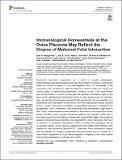Por favor, use este identificador para citar o enlazar a este item:
http://hdl.handle.net/10261/212340COMPARTIR / EXPORTAR:
 SHARE SHARE
 CORE
BASE CORE
BASE
|
|
| Visualizar otros formatos: MARC | Dublin Core | RDF | ORE | MODS | METS | DIDL | DATACITE | |

| Título: | Immunological homeostasis at the ovine placenta may reflect the degree of maternal fetal interaction |
Autor: | Wattegedera, S.; Doull, L. E.; Goncheva, M. I.; Wheelhouse, N. M.; Watson, D. M.; Pearce, J.; Benavides, Julio CSIC ORCID ; Palarea-Albaladejo, Javier; McInnes, C. J.; Ballingall, K.; Entrican, G. | Palabras clave: | Ovine Major histocompatibility complex Indoleamine 2,3 dioxygenase-1 Synepitheliochorial placentation Trophoblast |
Fecha de publicación: | 2019 | Editor: | Frontiers Media | Citación: | Frontiers in Immunology 9: 3025 (2019) | Resumen: | Successful mammalian pregnancies are a result of complex physiological, endocrinological, and immunological processes that combine to create an environment where the mother is tolerant to the semi-allogeneic fetus. Our knowledge of the mechanisms that contribute to maternal tolerance is derived mainly from human and murine studies of haemochorial placentation. However, as this is the most invasive type of placentation it cannot be assumed that identical mechanisms apply to the less invasive epitheliochorial placentation found in other species such as ruminants. Here, we examine three features associated with reproductive immune regulation in a transformed ovine trophoblast cell line and ex-vivo ovine reproductive tissues collected at term, namely: major histocompatibility complex (MHC) expression, Indoleamine 2,3 dioxygenase-1 (IDO-1) expression, and Natural Killer (NK) cell infiltration. High levels of MHC class I protein expression were detected at the surface of the trophoblast cell line using a pan-MHC class I specific monoclonal antibody. The majority of MHC class I transcripts isolated from the cell line clustered with classical MHC alleles. Transcriptional analysis of placental tissues identified only classical MHC class I transcripts. We found no evidence of constitutive transcription of IDO-1 in either the trophoblast cell line or placental tissues. Ex-vivo tissues collected from the materno-fetal interface were negative for cells expressing NKp46/NCR1. Collectively, these observations suggest that the relatively non-invasive synepitheliochorial placentation found in sheep has a more limited requirement for local immunoregulation compared to the more invasive haemochorial placentation of primates and rodents. | Descripción: | 10 páginas, 4 figuras. | Versión del editor: | http://dx.doi.org/10.3389/fimmu.2018.03025 | URI: | http://hdl.handle.net/10261/212340 | DOI: | 10.3389/fimmu.2018.03025 | Identificadores: | doi: 10.3389/fimmu.2018.03025 issn: 1664-3224 |
| Aparece en las colecciones: | (IGM) Artículos |
Ficheros en este ítem:
| Fichero | Descripción | Tamaño | Formato | |
|---|---|---|---|---|
| fimmu-09-03025.pdf | 1,48 MB | Adobe PDF |  Visualizar/Abrir |
CORE Recommender
PubMed Central
Citations
6
checked on 22-abr-2024
SCOPUSTM
Citations
7
checked on 19-abr-2024
WEB OF SCIENCETM
Citations
7
checked on 29-feb-2024
Page view(s)
148
checked on 24-abr-2024
Download(s)
87
checked on 24-abr-2024

